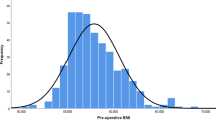Abstract
Background
There are no clinical guidelines or published studies addressing excessive weight loss and protein calorie malnutrition following a standard Roux-en-Y gastric bypass (RYGB) to guide nutritional management and treatment strategies. This study demonstrates the presentation, clinical algorithm, surgical technique, and outcomes of patients afflicted and successfully treated with excessive weight loss following a standard RYGB.
Methods
Three patients were successfully reversed to normal anatomy after evaluation, management, and treatment by multidisciplinary team. Lowest BMI (kg/m2) was 18.9, 17.9, and 14.2, respectively.
Results
Twelve-month post-operative BMI (kg/m2) was 28.9, 22.8, and 26.1, respectively. Lowest weight (lbs) was 117, 128, and 79, respectively. Twelve-month post-operative weight (lbs) was 179, 161, and 145, respectively. Pre-reversal gastrostomy tube was inserted into the remnant stomach to demonstrate weight gain and improve nutritional status prior to reversal to original anatomy.
Conclusion
We propose a practical clinical algorithm for the work-up and management of patients with excessive weight loss and protein calorie malnutrition after standard RYGB including reversal to normal anatomy.





Similar content being viewed by others
References
Buchwald H, Avidor Y, Braunwald E, et al. Bariatric surgery: a systematic review and meta-analysis. JAMA. 2004;292:1724–37.
Scopinaro N, Marinari GM, Camerini GB, et al. Specific effects of biliopancreatic diversion on the major components of metabolic syndrome. A long-term follow-up. Diabetes Care. 2005;28:2406–11.
Sugerman HJ, DeMaria EJ, Kellum JM, et al. Effects of bariatric surgery in older patients. Ann Surg. 2004;240:243–7.
Maggard MA, Shugaman LR, Suttorp M, et al. Meta analysis: surgical treatment of obesity. Ann Intern Med. 2005;142:547–59.
Fontaine KR, Redden DT, Wang C, et al. Years of life lost due to obesity. JAMA. 2003;289:187–93.
Blackstone R, Dimick J, Nguyen NT. Accreditation in metabolic and bariatric surgery: pro versus con. Surg Obes Relat Dis. 2014;10:198–202.
Kwon S, Wang B, Wong E, et al. The impact of accreditation on safety and cost of bariatric surgery. Surg Obes Relat Dis. 2013;9:617–22.
El Chaar M, Claros L, Ezeji GC, et al. Improving outcome of bariatric surgery: best practices in an accredited surgical center. Obes Surg. 2014;24:1057–63.
Morton J. The first metabolic and bariatric surgery accreditation and quality improvement program quality initiative: decreasing readmissions through opportunities provided. Surg Obes Relat Dis. 2014;10:377–8.
Kohn GP, Galanko JA, Overby DW, et al. High case volumes and surgical fellowships are associated with improved outcomes for bariatric surgery patients: a justification of current credentialing initiatives for practice and training. J Am Chem Soc. 2010;210:909–18.
Hutter MM, Schirmer BD, Jones DB, et al. First report from the American College of Surgeons Bariatric Surgery Center Network: laparoscopic sleeve gastrectomy has morbidity and effectiveness positioned between the band and bypass. Ann Surg. 2011;254:410–22.
DeMaria EJ, Pate V, Warthen M, et al. Baseline data from American Society for Metabolic and Bariatric Surgery-Designated Bariatric Surgery Centers of Excellence using the Bariatric Outcomes Longitudinal Database. Surg Obes Relat Dis. 2010;6:347–55.
Flum DR, Belle SH, King WC, et al. Perioperative safety in the longitudinal assessment of bariatric surgery. NEJM. 2009;361:445–54.
Brolin RE. Gastric bypass. Surg Clin N Am. 2001;81:1077–95.
Nemni J. Severe chronic cough after Lap-Band gastric surgery. Can Respir J. 2007;14:171–2.
Ambrecht U, Lundell L, Lindstedt G, et al. Causes of malabsorption after total gastrectomy with Roux-en-Y reconstruction. Acta Chir Scand. 1988;154:37–41.
Jones KB. Biliopancreatic limb obstruction in gastric bypass at or proximal to the jejunojejunostomy: a potentially deadly, catastrophic event. Obes Surg. 1996;6:485–93.
Higa KD, Boone KB, Ho T. Complications of the laparoscopic Roux-en-Y gastric bypass: 1,040 patients—what have we learned? Obes Surg. 2000;10:509–13.
Bradley JE, Brown RO, Luther RW. Multiple nutritional deficiencies and metabolic complications 20 years after jejunoileal bypass surgery. JPEN J Parenter Enteral Nutr. 1987;11:494–8.
Behrns KE, Smith CD, Kelly KA, et al. Reoperative bariatric surgery: lessons learned to improve patient selection and results. Ann Surg. 1993;218:646–53.
Sugerman HJ, Kellum JM, DeMaria EJ. Conversion of proximal to distal gastric bypass for failed gastric bypass for superobesity. J Gastrointest Surg. 1997;1:517–24.
Brolin RE, Cody RP. Adding malabsorption for weight loss failure after gastric bypass. Surg Endosc. 2007;21:1924–6.
Stefanidis D, Kuwada TS, Gersin KS. The importance of the length of the limbs for gastric bypass patients—an evidence based review. Obes Surg. 2011;21:119–24.
Bock MA. Roux-en-Y gastric bypass: the dietician’s and patient’s perspectives. Nutr Clin Pract. 2003;18:141–4.
Faintuch J, Matsuda M, Cruz ME, et al. Severe protein-calorie malnutrition after bariatric procedures. Obes Surg. 2004;14:175–81.
Segal A, Kinoshita Kussunoki D, Larino MA. Post-surgical refusal to eat: anorexia nervosa, bulimia nervosa or a new eating disorder? A case series. Obes Surg. 2004;14:353–60.
Chousleb E, Patel S, Szomstein S, et al. Reasons and operative outcomes after reversal of gastric bypass and jejunoileal bypass. Obes Surg. 2012;22:1611–6.
Brolin RE, Asad M. Rationale for reversal of failed bariatric operations. Surg Obes Relat Dis. 2009;5:673–6.
Campos GM, Ziemelis M, Paparodis R, et al. Laparoscopic reversal of Roux-en-Y gastric bypass: technique and utility for treatment of endocrine complications. Surg Obes Relat Dis. 2014;10:36–43.
Vilallonga R, van de Vrande S, Himpens J. Laparoscopic reversal of Roux-en-Y gastric bypass into normal anatomy with or without sleeve gastrectomy. Surg Endosc. 2013;27:4640–8.
Dapri G, Cadiere GB, Himpens J. Laparoscopic reconversion of Roux-en-Y gastric bypass to original anatomy: technique and preliminary outcomes. Obes Surg. 2011;21:1289–95.
Korbonits M, Blaine D, Elia M, et al. Metabolic and hormonal changes during the refeeding period of prolonged fasting. Eur J Endocrinol. 2007;157:157–66.
Gariballa S. Refeeding syndrome: a potentially fatal condition but remains underdiagnosed and undertreated. Nutrition. 2008;24:604–6.
Conflict of Interest
The authors declare that they have no competing interests.
Consent
For this type of study, formal consent is not required. Additional informed consent was obtained from all individual participants for whom identifying information is included in this article.
Author information
Authors and Affiliations
Corresponding author
Rights and permissions
About this article
Cite this article
Akusoba, I., Birriel, T.J. & El Chaar, M. Management of Excessive Weight Loss Following Laparoscopic Roux-en-Y Gastric Bypass: Clinical Algorithm and Surgical Techniques. OBES SURG 26, 5–11 (2016). https://doi.org/10.1007/s11695-015-1775-7
Published:
Issue Date:
DOI: https://doi.org/10.1007/s11695-015-1775-7




